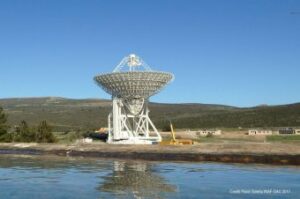The Sardinia Radio Telescope. Credits: Paolo Soletta / INAF Cagliari
How can you see a ping-pong ball from seven thousand km away? Imagine being able to observe a dozen ping-pong balls floating inside a large tank, full but with the bottom plug open creating the classic vortex. Only you’re in Rome while the tank is in New York. Impossible task, right? Also because, apart from a telescope yet to be invented, we would have to assume a flat Earth.
But let’s imagine it anyway, because it’s on these proportions that a study is based – just accepted and soon to be published in the journal Astronomy & Astrophysics – carried out by a team of researchers led by Alberto Sanna from the Max Planck Institute for Radio Astronomy in Bonn together with five co-authors, including Luca Moscadelli from the Arcetri Astrophysical Observatory and Gabriele Surcis from the Cagliari Astronomical Observatory, both research centers of INAF.

The water in the tank would be a cloud of gas and dust forming a star. The ping-pong balls would be the masers: molecular clouds of various chemical compositions (in this case methanol) capable of acting as markers of these gaseous clouds in various astrophysical environments, including the initial and final phases of a star’s life. The seven thousand km separating Rome and New York would become a whopping two hundred million billion kilometers (or, otherwise said, 700 parsecs, equivalent to about 2300 light years).
Radio telescopes in network: observational tools (for now) unsurpassed
What interests us most, however, is that the “telescope” to see so detailed from an enormous distance was not just one, but eight radio telescopes of the EVN network (European VLBI Network) that observed a young protostar in three distinct “epochs”, one year apart: in 2013, 2014, and 2015.
Partial reproduction of the EVN network. Credits: Paul Boven. Satellite image: Blue Marble Next Generation, courtesy of NASA Visible Earth
“The observational technique we used, called Very Long Baseline Interferometry (VLBI),” explains Sanna, “allows us to achieve the highest possible spatial resolutions today. When applied to the study of maser emissions, which act as small probes to study the behavior of spatial regions similar to the Earth-Sun distance, it becomes a unique tool to understand how stars with much greater masses than the Sun form.”
During the last observation, in 2015, SRT, the Sardinia Radio Telescope, was also used, the large Sardinian antenna that “demonstrated its great potential even in interferometric mode, improving the sensitivity of the observations and, therefore, the quality of the images during the last session,” says Surcis, now a researcher at INAF and, at the time of the observations, at the Joint Institute for VLBI in Europe (JIVE) as a support scientist with data control functions.
One more dimension, and a new doubt
So we come to the observed object (that is, in our metaphor, the entire tank with the moving water): Cepheus A HW2 is a very young and massive star in the Cepheus A star-forming region, the second closest to Earth after the Orion Nebula. It is surrounded by gas and dust that are swirling around the central core (hence the study’s title, in English, talks about “planar infall”), and whose movements are observable thanks to the masers.
The novelty of the study conducted by Sanna and collaborators lies in having derived for the first time with great accuracy the three-dimensional motion of the enormous gas mass. An aspect, this 3D study, that in fact surpasses previous observations. “The great advantage of the measurements made with masers,” emphasizes Moscadelli, author of the code used for the observations, “is that they provide accurate positions in the sky plane and three-dimensional velocities: that is, both the component along the line of sight and that in the sky plane. Thus making it possible to check if these velocities are coplanar and establish if the motion of the masers occurs in a preferential plane, in this case, the plane of the disk rotating around the forming star.”
Another interesting aspect that emerged from the observations is that the gas velocities were slower than expected near the star. A phenomenon that could be due to a magnetic field concurrent with the gravitational forces at play. Here it is useful to remember the open plug at the bottom of our metaphorical tank: the balls near the vortex obviously go faster than the peripheral ones, which will still take time to reach the whirlpool. So it is also for the masers of Cepheus, but these, indeed, go slower than expected.
In short, there is still much to discover about this forming star. Meanwhile, the scientific world continues to question masers. Right in Cagliari, from September 4 to 8, the symposium of the International Astronomical Union (IAU) Astrophysical Masers: Unlocking the Mysteries of the Universe will be held. For four days, about one hundred and fifty “maserists” from around the world will take stock of these objects, and Sanna’s article, as well as the future role of the Sardinia Radio Telescope in this type of observations, will be among the topics of discussion.
To learn more:
Read the preprint of the article “Planar infall of CH3OH gas around Cepheus A HW2”, by A. Sanna, L. Moscadelli, G. Surcis, H.J. van Langevelde, K.J.E. Torstensson, A.M. Sobolev